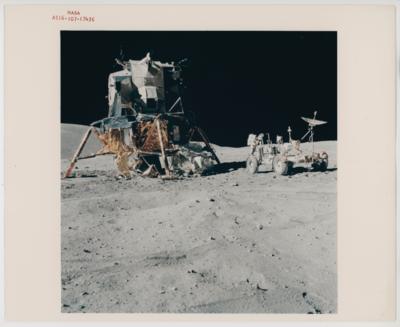Charles Duke (Apollo 16)
John Young at Descartes Base behind the Rover and the LM Orion, 16-27 April 1972
Vintage chromogenic print on fiber-based paper, printed 1972, numbered "NASA AS16-107-17436" (NASA MSC) in red in top margin, with "A KODAK PAPER" watermark on verso, 25,4 x 20,3 cm
Below the ‘United States’ sign on the LM is the Modularized Equipment Stowage Assembly (MESA) pallet, a storage area for experiments and tools. A white insulation blanket protects the area from excessive heating and cooling. To the left is a white area with gold-colored insulation draping to the surface. This is the quad III payload area, a storage area for the far-UV camera/spectrograph, the lunar portable magnetometer, and hand tools. The probes sticking up from the two landing pads are designed to detect LM touchdown on the Moon and then to crush and bend out of the way during the completion of the landing maneuver. (NASA SP-315, p. 4.15)
“This and similar views of the LM, Rover and our flag were always special. Other than the gray and white of the Moon, this was the only color. What a contrast to the stark Moon. The landing site that John selected was dead level so this made the deployment of the rover and the ALSEP a simple task.”
Charles Duke (Constantine, p. 99)
Literature:
Apollo 16 Preliminary Science Report, (NASA SP-315), 1972, pg. 4-15; Apollo: The Panoramas, Constantine, pg. 99.
Specialist: Mag. Eva Königseder
 Mag. Eva Königseder
Mag. Eva Königseder
+43-1-515 60-421
eva.koenigseder@dorotheum.at
27.09.2023 - 17:24
- Realized price: **
-
EUR 1,040.-
- Estimate:
-
EUR 1,000.- to EUR 1,500.-
- Starting bid:
-
EUR 100.-
Charles Duke (Apollo 16)
John Young at Descartes Base behind the Rover and the LM Orion, 16-27 April 1972
Vintage chromogenic print on fiber-based paper, printed 1972, numbered "NASA AS16-107-17436" (NASA MSC) in red in top margin, with "A KODAK PAPER" watermark on verso, 25,4 x 20,3 cm
Below the ‘United States’ sign on the LM is the Modularized Equipment Stowage Assembly (MESA) pallet, a storage area for experiments and tools. A white insulation blanket protects the area from excessive heating and cooling. To the left is a white area with gold-colored insulation draping to the surface. This is the quad III payload area, a storage area for the far-UV camera/spectrograph, the lunar portable magnetometer, and hand tools. The probes sticking up from the two landing pads are designed to detect LM touchdown on the Moon and then to crush and bend out of the way during the completion of the landing maneuver. (NASA SP-315, p. 4.15)
“This and similar views of the LM, Rover and our flag were always special. Other than the gray and white of the Moon, this was the only color. What a contrast to the stark Moon. The landing site that John selected was dead level so this made the deployment of the rover and the ALSEP a simple task.”
Charles Duke (Constantine, p. 99)
Literature:
Apollo 16 Preliminary Science Report, (NASA SP-315), 1972, pg. 4-15; Apollo: The Panoramas, Constantine, pg. 99.
Specialist: Mag. Eva Königseder
 Mag. Eva Königseder
Mag. Eva Königseder
+43-1-515 60-421
eva.koenigseder@dorotheum.at
|
Buyers hotline
Mon.-Fri.: 10.00am - 5.00pm
kundendienst@dorotheum.at +43 1 515 60 200 |
| Auction: | The Beauty of Space - Iconic Photographs of Early NASA Missions |
| Auction type: | Online auction |
| Date: | 27.09.2023 - 17:24 |
| Location: | Wien | Palais Dorotheum |
| Exhibition: | Online |
** Purchase price incl. buyer's premium and VAT
It is not possible to turn in online buying orders anymore. The auction is in preparation or has been executed already.

